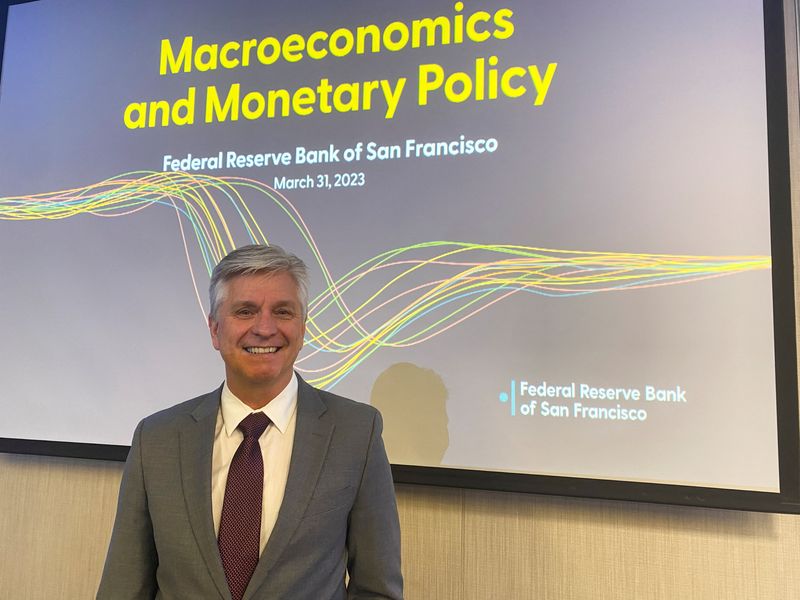Economy
Fed’s Waller: Continued inflation declines in coming months could warrant rate cuts


© Reuters. FILE PHOTO: Federal Reserve Board Governor Christopher Waller poses before a speech at the San Francisco Fed, in San Francisco, California, U.S., March 31, 2023. REUTERS/Ann Saphir/FIle Photo
By Howard Schneider and Ann Saphir
WASHINGTON (Reuters) – U.S. Federal Reserve Governor Christopher Waller said on Tuesday he is “increasingly confident” the current setting of the central bank’s benchmark interest rate will prove adequate to lower inflation to the Fed’s 2% target and nodded to possible rate cuts in a matter of months if progress on lowering inflation continues.
“Inflation rates are moving along pretty much like I thought,” Waller said during an event at the American Enterprise Institute. If progress continues “for several more months…three months, four months, five months…we could start lowering the policy rate just because inflation is lower.
“It has nothing to do with trying to save the economy. It is consistent with every policy rule. There is no reason to say we will keep it really high.”
Waller’s prepared remarks and responses to questions contained the same caveats all Fed officials currently use in their public remarks, noting that “inflation is still too high, and it is too early to say whether the slowing we are seeing will be sustained.”
Additional rate increases remained a possibility if upcoming data includes an unexpected resurgence of price pressures, he said.
But his remarks also demonstrated growing comfort at the Fed that rates probably won’t need to move higher, and that the economy can see inflation fall without a major blow to economic growth or jobs.
“As long as you don’t get any big shocks, I am reasonably confident that we can pull off this soft landing,” Waller said.
Part of that will be continuing to calibrate the benchmark policy rate against the rate of inflation, with continued declines in the pace of price increases warranting eventual rate cuts — a point other officials have made.
But Waller’s comments indicate that a clock is ticking, assuming that inflation continues to march down.
Waller said he now sees several reasons to believe that will be the case.
“I am increasingly confident that policy is currently well positioned to slow the economy and get inflation back to 2%,” Waller said.
After a period when faster-than-expected U.S. economic growth threatened to reverse a steady easing of inflation, Waller said, “I am encouraged by what we have learned in the past few weeks – something appears to be giving, and it’s the pace of the economy,” rather than the progress on inflation, which he said appears to be edging steadily lower.
The Fed at its last meeting held the benchmark interest rate steady in a range of 5.25% to 5.5%, and analysts with near certainty expect the same outcome at the next policy meeting on Dec. 12-13. Investors also expect the Fed to begin cutting rates in May.
New inflation data will be released on Thursday, and policymakers will also have fresh jobs and other data in hand before they gather.
But Waller ticked off a healthy list of recent data that have already moved in the Fed’s direction, with consumer prices flat in October, retail spending easing, and a slow easing in wage growth.
The job market does remain “fairly tight,” and bears watching, he said, while a recent drop in long-term market interest rates has tempered some of the credit tightening the Fed relies on to slow the economy.
But long-term interest rates “are still higher than they were before the middle of the year, and overall financial conditions are tighter, which should be putting downward pressure on household and business spending,” Waller said.
“All in all, it seems like output growth is moderating as I had hoped it would, supporting continued progress on inflation.”
Economy
Russian central bank says it needs months to make sure CPI falling before rate cuts -RBC


© Reuters. Russian Central Bank Governor Elvira Nabiullina attends a news conference in Moscow, Russia June 14, 2019. REUTERS/Shamil Zhumatov/File Photo
MOSCOW (Reuters) – Russia’s central bank will need two to three months to make sure that inflation is steadily declining before taking any decision on interest rate cuts, the bank’s governor Elvira Nabiullina told RBC media on Sunday.
The central bank raised its key interest rate by 100 basis points to 16% earlier in December, hiking for the fifth consecutive meeting in response to stubborn inflation, and suggested that its tightening cycle was nearly over.
Nabiullina said it was not yet clear when exactly the regulator would start cutting rates, however.
“We really need to make sure that inflation is steadily decreasing, that these are not one-off factors that can affect the rate of price growth in a particular month,” she said.
Nabiullina said the bank was taking into account a wide range of indicators but primarily those that “characterize the stability of inflation”.
“This will take two or three months or more – it depends on how much the wide range of indicators that characterize sustainable inflation declines,” she said.
The bank will next convene to set its benchmark rate on Feb. 16.
The governor also said the bank should have started monetary policy tightening earlier than in July, when it embarked on the rate-hiking cycle.
Economy
China identifies second set of projects in $140 billion spending plan


© Reuters. FILE PHOTO: Workers walk past an under-construction area with completed office towers in the background, in Shenzhen’s Qianhai new district, Guangdong province, China August 25, 2023. REUTERS/David Kirton/File Photo
SHANGHAI (Reuters) – China’s top planning body said on Saturday it had identified a second batch of public investment projects, including flood control and disaster relief programmes, under a bond issuance and investment plan announced in October to boost the economy.
With the latest tranche, China has now earmarked more than 800 billion yuan of its 1 trillion yuan ($140 billion) in additional government bond issuance in the fourth quarter, as it focuses on fiscal steps to shore up the flagging economy.
The National Development and Reform Commission (NDRC) said in a statement on Saturday it had identified 9,600 projects with planned investment of more than 560 billion yuan.
China’s economy, the world’s second largest, is struggling to regain its footing post-COVID-19 as policymakers grapple with tepid consumer demand, weak exports, falling foreign investment and a deepening real estate crisis.
The 1 trillion yuan in additional bond issuance will widen China’s 2023 budget deficit ratio to around 3.8 percent from 3 percent, the state-run Xinhua news agency has said.
“Construction of the projects will improve China’s flood control system, emergency response mechanism and disaster relief capabilities, and better protect people’s lives and property, so it is very significant,” the NDRC said.
The agency said it will coordinate with other government bodies to make sure that funds are allocated speedily for investment and that high standards of quality are maintained in project construction.
($1 = 7.1315 renminbi)
Economy
Russian central bank says it needs months to make sure CPI falling before rate cuts -RBC


© Reuters. Russian Central Bank Governor Elvira Nabiullina attends a news conference in Moscow, Russia June 14, 2019. REUTERS/Shamil Zhumatov/File Photo
MOSCOW (Reuters) – Russia’s central bank will need two to three months to make sure that inflation is steadily declining before taking any decision on interest rate cuts, the bank’s governor Elvira Nabiullina told RBC media on Sunday.
The central bank raised its key interest rate by 100 basis points to 16% earlier in December, hiking for the fifth consecutive meeting in response to stubborn inflation, and suggested that its tightening cycle was nearly over.
Nabiullina said it was not yet clear when exactly the regulator would start cutting rates, however.
“We really need to make sure that inflation is steadily decreasing, that these are not one-off factors that can affect the rate of price growth in a particular month,” she said.
Nabiullina said the bank was taking into account a wide range of indicators but primarily those that “characterize the stability of inflation”.
“This will take two or three months or more – it depends on how much the wide range of indicators that characterize sustainable inflation declines,” she said.
The bank will next convene to set its benchmark rate on Feb. 16.
The governor also said the bank should have started monetary policy tightening earlier than in July, when it embarked on the rate-hiking cycle.

 Forex3 years ago
Forex3 years agoForex Today: the dollar is gaining strength amid gloomy sentiment at the start of the Fed’s week

 Forex3 years ago
Forex3 years agoUnbiased review of Pocket Option broker

 Forex3 years ago
Forex3 years agoDollar to pound sterling exchange rate today: Pound plummeted to its lowest since 1985

 Forex3 years ago
Forex3 years agoHow is the Australian dollar doing today?

 Cryptocurrency3 years ago
Cryptocurrency3 years agoWhat happened in the crypto market – current events today

 World3 years ago
World3 years agoWhy are modern video games an art form?

 Commodities3 years ago
Commodities3 years agoCopper continues to fall in price on expectations of lower demand in China

 Economy3 years ago
Economy3 years agoCrude oil tankers double in price due to EU anti-Russian sanctions























